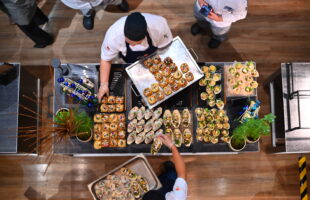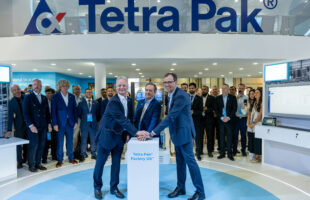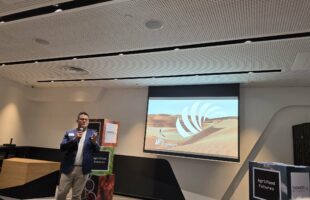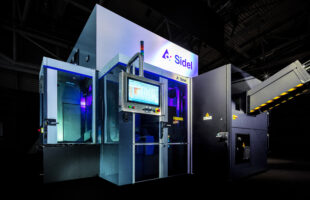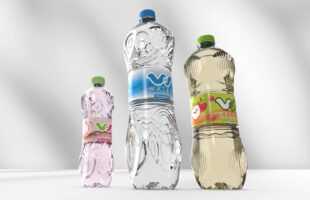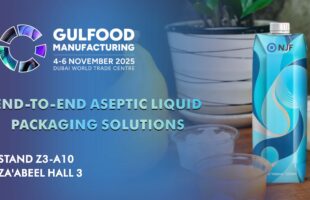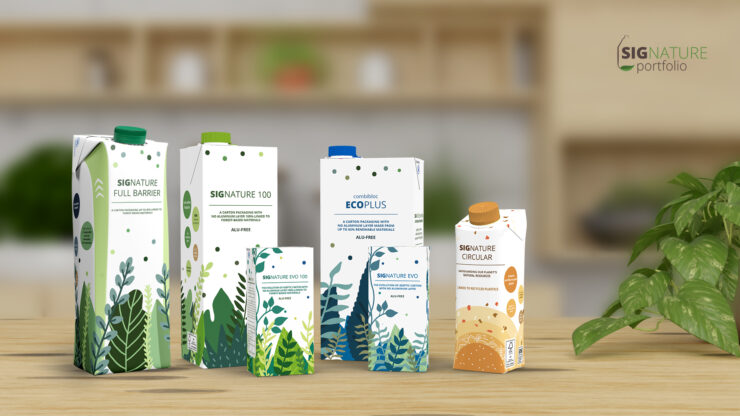
Courtesy of SIG
By Cath Isabedra
Food packaging and food waste are two of the biggest contributors to landfill. The problem with food packaging is that it’s often unnecessary, used to deliver food but not consumed. Take plastic wraps for fruit and vegetables. They’re designed to keep the product fresh for longer but are optional for most people who buy their produce weekly at the local grocery store.
The packaging industry is booming. Pre-pandemic, packaging was well on its way to becoming a trillion-dollar industry, recording a compound annual growth rate (CAGR) of 2.0 percent from 2015 to 2019. With the pandemic easing restrictions, the market is estimated to hit US$1.13 trillion by 2030. Part of this growth is the growing commitment of companies toward sustainability.
Angela Lu, President and General Manager at SIG (Asia Pacific South), shared that the concept of circular economy has gained attention from consumers and governments globally. This increased awareness pushed manufacturers to make it part of their efforts. “When we talk about sustainable solutions, we focus largely on the increased use of life cycle assessment to reduce environmental impact and ecological footprint.”
She adds that SIG is among those that rallied to ensure their operations align with net-zero initiatives. “SIG products are already sustainable by nature – all our packs are not only made from forest-based paperboard but they are also made with 100 percent renewable energy, making us the first in the industry to achieve a carbon-neutral production.”
The food waste problem is huge.
It’s a global problem, affecting the US and UK in particular. Food waste is also a global problem. The amount of food that goes to waste each year is staggering—the UN estimates that one-third of all food produced for human consumption gets thrown away or wasted globally every year. And this significantly contributes to climate change.
Gone are the days when companies focused on branding and style. More recently, they also have to ensure that they think about environmental factors as well. Beyond branded packaging, consumers are now conscious of their purchases. They are more likely to buy from companies with sustainable practices.
Lu shares that manufacturing and packaging logistics are the main sources of greenhouse gas (GHG) emissions. But it doesn’t mean there’s no way to reduce the carbon footprint.
Plastics are a large part of the problem.
Plastics are a large part of the problem. Plastics are hard to recycle and create pollution when made into products like food packaging.
Plastic packaging is made from petrochemicals such as polyethylene (PE), polypropylene (PP), high-density polyethylene (HDPE), low-density polyethylene (LDPE), and some types of polystyrene. This means that most plastics can’t be recycled at all.
The second problem with plastic packaging is how much land it takes up in our world’s ecosystems when we throw away so much refuse daily. According to the OECD, plastics are responsible for emitting 3.4 percent of global GHG emissions throughout their lifecycle.
Recyclable and biodegradable packaging exists, but the solutions are not simple.
There are many different types of packaging, some being more environmentally friendly than others. For example, it’s important to distinguish between recyclable and biodegradable plastics because they’re often used interchangeably in food packaging.
SIG held a sustainable packaging webinar last November and shared their findings that beverage cartons produce the lowest carbon footprint among packaging in the milk and juice category. Lu explains, “The low carbon footprint is not just applicable materials-wise, but also in terms of logistics – one lorry load of shipment can carry 12,000 more cartons than cans, thanks to its regular shape and lightweight material.”
One possible solution is investing in reengineered packaging. But it’s not always easy. Cost-wise, not everyone can invest their resources in each and every piece of food packaging.
Lu explains that packaging takes up a chunk of manufacturing costs. “Typically, companies spend 10% to 40 percent of the product’s retail price on the packaging.” However, reengineered packaging offers huge savings in the long run. “Reengineering packaging revolves around redesigning and improving the entire packaging supply chain while bringing new efficiencies to the supply chain management. It is especially relevant when it involves the integrity of food packaging during transportation.”
She adds, “Savings through logistics and storage, along with improvements in aesthetics and safety factors, are some of the push factors for manufacturers to consider reengineering their packaging.”
Longer shelf life means less food waste.
In the United States, a lot of food waste occurs in the form of spoiled or unsold produce. This can be due to factors such as improper storage and improper handling by consumers, who may need help understanding how long a particular item will last before it goes bad.
Food packaging has been shown to extend shelf life significantly by providing an environment for slow decomposition so that bacteria do not have time to grow on your product as quickly. With supply chain issues still an issue, many can’t help but wonder about product shelf-life.
Aseptic packaging can be a solution for some kinds of food.
Aseptic packaging is a process that involves filling the package with gas, then sealing it. The gas keeps bacteria out of the product while preventing oxygen from getting inside. It’s used for products that need to be kept fresh for long periods of time and need to stay sealed so they don’t spoil or decompose over time.
This type of packaging is ideal for milk, yogurt, juice, and other foods that don’t need their own special type of container. It can also be used on meats, but only if you want your meat to last longer without going bad before you use it up completely
Aseptic carton packaging is one solution. Lu shares that this packaging ensures long shelf-life by preventing UV light, oxygen, and moisture – elements that are detrimental to food products’ shelf life. She shares that these elements “promote the growth of mould, cause nutrients to degrade and drain the food products of their colours and flavours.”
But shelf-life isn’t just within the transportation. Manufacturers also have to think about the shelf life during the display period in stores, including the consumption span after consumers buy the products and use them repeatedly.
“Aseptic carton packaging helps products enjoy a longer pantry shelf life through the incorporation of reliable closure tops as well,” Lu explains.
“To meet the demand of sustainable packaging, apart from our SIGNATURE EVO as mentioned earlier, our SIGNATURE FULL BARRIER is another format in our extensive range that provides full barrier coverage from the harmful effects of the listed external factors while maintaining sustainability and the lowest carbon footprint possible. For example, SIGNATURE FULL BARRIER is linked to up to 95% forest-based renewable materials. All three raw materials responsible for the full barrier packaging – aluminum layer, paper board layer, and polymer layer – are all sourced from certified responsible sources.”
Packaging is critical to reducing food waste.
Food packaging plays an important role in the food supply chain and can help extend shelf life and reduce spoilage while promoting consumer confidence in products.
“At SIG, we understand that different manufacturers require different variations of packaging formats and, at the same time, balancing prices and carbon footprint. This understanding results in developing our extensive range of packaging solutions that consist of a high share of renewable content, are fully recyclable, and are made from 100% renewable electricity, allowing us to achieve carbon-neutral production.”
The future of packaging is geared toward sustainability.
When asked what innovations food manufacturers can expect in aseptic packaging, Lu shares the one thing that all should look forward to – flexibility.
“Besides improvements in sustainability, such as a lower carbon footprint, production flexibility is also a key focus. Filling technology should be fast, flexible, efficient, reliable, and reduce operating costs – SIG’s next-generation filling technology significantly advances these benefits. Since consumer trends are constantly changing, food and beverage players need to react fast to meet new demands while they should not compromise efficiency. An agile, flexible, and high-performance machine innovation is an answer to this.”
And it’s exciting to know that SIG is paving the way to make this happen. “Our SIG NEO machine achieves a 60 percent reduction in water usage, plus up to 25 percent reduction in greenhouse emissions per filled pack. With a design speed of 18,000 packs per hour, capable of volume flexibility for CAPEX optimization, it is set to have the highest output per hour for mid-size carton packaging in the market today with proven improvements in operating costs as less consumption of utilities & consumables.”
With insights from Angela Lu, President and General Manager at SIG Asia Pacific South. Angela Lu joined SIG in 2022. She has spent more than 10 years with Nestlé in Switzerland and several Asia Pacific key markets such as Singapore, Thailand, China, and Australia in different leadership positions. Previously, she has worked at leading multinational FMCG companies, including the Coca-Cola Company, Fonterra, and Gilette. Most recently, she worked at Yeo Hiap Seng, a leading brand in the Asian drinks market. Angela holds a Bachelor’s degree in Industrial Management Engineering (Marketing) from Tongji University in China and an MBA from Nanyang Technological University in Singapore.


